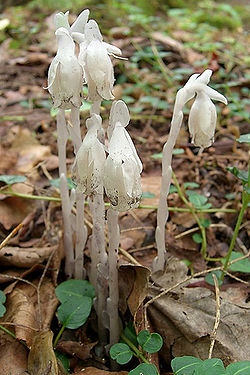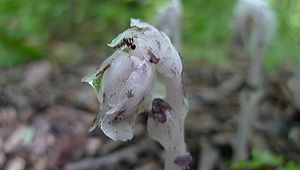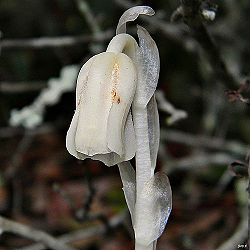Indianpipe
| Indianpipe |
|---|

|
| Scientific Classification |
|
| Binomial Name |
|
Monotropa uniflora |
| Habitat Range of Indian Pipe. |
The Indian pipe (Monotropa uniflora) is also known as a Corpse Plant and Ghost Plant. It is the yellowish, whitish plant that lives in shaded and wet areas. The plant does not possess chlorophyll. Which means it cannot produce or create nutrition for itself. It lives next from trees because the plant receives energy and fungus. The mycorrhizal relationship occurs between tree and Indian pipe. It can also be used for medicine. Indian pipe appears across the world. [2]
Body Design
'Monotropa uniflora' is herbaceous plant and perennial plant. Its color is pinkish white plant. It usually has the length of 10 to 30cm long. It is ghostly white because of its color looks like ghost. The scale-like leaves grow from the peduncle. It does not need any light from the sun. Which means the flower does not create the photosynthesis. The leaves have black dots. The important fact about 'Monotropa uniflora' is that it is one flower plant. Which means the plant only has one flower from its stem. The flower faces down in its early stage of growth. During the maturity of the flower, the stem and flower are at a 90 degree angle from each other. Also the plant possesses the capsule fruit. After the maturity, the stem and flower separate to a 180 degree angle from each other. The seed starts to appear from the base of capsule. The seed dispersal happens in that time. The plant stays the same after the dispersal.[2]
Life Cycle
Indian pipe (Monotropa uniflora) grows from the tree and the fungus. The roots of Indian pipe get the energy and nutrients from the mycelia. Mycelium is thread like body of the fungus. Mycelium is the singular version of the mycelia. The mycelium is also taking the energy from the tree. The relationship between fungi and tree is mycorrhizal relationship. Indian pipe only receives the energy from both tree and fungus. Bumble bees use this plant as energy source for survival. This plant is also known to be parasite to both of them. However out of all the species from Indian pipe, only few of them are parasite to both of them. Russula mushrooms and Lactarius mushrooms are known to be the source of these progresses around the certain and few Indian Pipes. The mycorrhizal relationships come between these two organisms. [3][4] Indian pipe is the perennial plant. The plant lives for multiple years. The blooming time frame of Indian pipe is June to September in mature, moist, shaded, wet forests. After the growth formation and processes, stem loses its moisture. The Capsule of the plant turns to upside and continues to stay in that way until the next growth occurs.[5]
Ecology
Indian pipe appears in the shade of forests. It also needs moisture throughout its growth. Indian pipe needs to be bonded with forest trees and fungus because they provide the nutrition for the plant. Indian pipes cannot live without any of those two. The tree provides fungus the carbohydrates. The fungus provides the liquid (water). Indian pipe only receives. It does not provide anything for trees and fungus. Indian pipe needs to be in very moisture area and shaded area to live. The plant grows without maximum of sunlight unlike other plants. Of Course, it means the plant does not need any photosynthesis. The rich forest soil is the number one environment that Indian pipes have to live in. June to September, Indian pipes, the perennial plant, grow rapidly. After the season is passed, it comes back to grow again year after year. [4]
Historic Medcine
Native Americans used the plant medicinally. They made a juice from the stem that was applied as an eye treatment to cure sore eyes and inflamed eyes. It was called 'Eyebright' because it helped to cure the sickness and infection, but also took away the pains. The early colonists also used powdered roots to treat a nervous and scary condition. The usual names for its treatment and theory were 'Fit Root' and 'Convulsion Root'. A lot of physicians tried using these methods. They tried to use as other early adapters. However the physicians figured out it is actually dangerous to use Indian pipes as treatment for human eye. The plant possessed some toxic in it.[6]
Video
Indian Pipe Anatomy
References
- ↑ Unknown Author.Monotropa uniflora. USDA. Web. Accessed in May 2, 2012.
- ↑ 2.0 2.1 Unknown Author. Monotropa uniflora – Ghost Plant, Indian Pipe US Forest Service. Web. Accessed in May 8, 2012.
- ↑ Unknown Author. Indian Pipe fcsp.edu. Web. Accessed in May 8, 2012.
- ↑ 4.0 4.1 Unknown Author. [http://www.macphailwoods.org/indianpipe.html Indian Pipe (Monotropa uniflora) Macphail Woods Ecological Forestry Project. Web. May 8, 2012.
- ↑ Unknown Authors. Monotropa uniflora (Indian Pipe) minnesotawildflowers. Web. Accessed in May 20, 2012
- ↑ Unknown author. Indian Pipe sierrapotomac.org. Web. Accessed in May 9, 2012.



